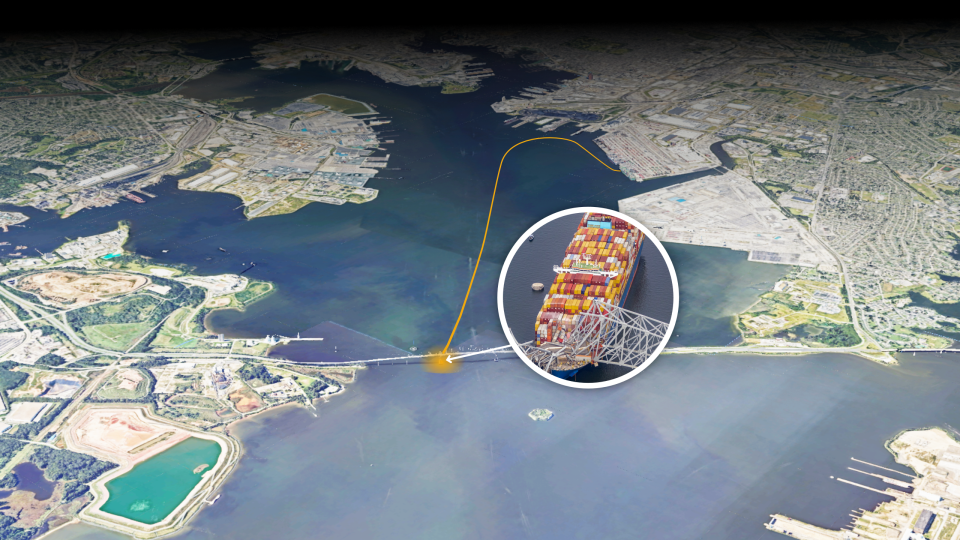Time, money, lost business are part of hefty price tag to rebuild critical Baltimore bridge
The Francis Scott Key Bridge - and more importantly its capability to support traffic of 33,000 vehicles a day - could take years to rebuild after a cargo ship slammed into it and sent the 1.6 mile roadway tumbling into the Patapsco River.
While state officials have not released timelines on bridge repairs, experts say it could take several months or even up to four years until the bridge can make a comeback.
When the bridge opened in 1977, it cost $60.3 million, which is equivalent to $316 million today. The bridge took five years to complete, but experts say reopening it could take less time depending on several factors, including the condition of the bridge's foundational pieces underwater, design plans, and funding. President Joe Biden has said he expects the federal government to cover all rebuilding costs.
The Army Corps of Engineers has activated its emergency operations center following the collapse, authorizing more than 1,100 personnel to support recovery efforts and clear the busy shipping channel of debris, the Army announced Tuesday. The Corps, supporting local, state and federal agencies, is providing an underwater drone, structural engineers, urban search and rescue specialists, and the Reynolds, a vessel that collects debris that could pose hazardous to navigation.
In the meantime, experts warn the downed bridge could have major implications for East Coast shipping as companies scramble to find other ports and residents are diverted to detours. About 12.4 million vehicles crossed the bridge in 2023.
Assessing the damage
Illinois Institute of Technology engineering professor Gongkang Fu said the first step to rebuilding will be to assess the foundational pieces of the bridge underwater.
“The pieces we don't see...are more expensive than the pieces we see, normally,” Fu said.
Building the underwater part can account for as much as half of the construction time, Fu said, so the condition of those pieces will greatly determine how long rebuilding will take.
How fast funds come in will also determine when the bridge can reopen, Fu said, noting that expediting construction raises costs.
The target bridge lifespan in current national guidelines is 75 years, Fu said.
Hota GangaRao, the director of the Constructed Facilities Center at West Virginia University’s Department of Civil and Environmental Engineering, said several bridge piers could be damaged by the collapse. But engineers would need to assess the underwater structure to see the extent.
Based on the size of the bridge, GangaRao estimated rebuilding the structure will cost at least $350 million, and take two to four years to complete.
Sameh Badie, engineering professor at George Washington University, said the cost of rebuilding the bridge will also depend on the new design. More technologies are available now than when the bridge was originally built nearly five decades ago. Engineers may also take Tuesday’s collision into consideration when deciding on the new structure as more information is released.
David Turner, spokesperson for Maryland Gov. Wes Moore, told USA TODAY timelines and cost estimates on bridge repairs were not yet available but the process will be “long and expensive.”

Detours, other ports take Baltimore load
Moody’s Analytics senior economist Adam Kamins said the bridge collapse could have a significant impact on the Maryland economy, along with broader national and potentially global implications. Kamins noted the Port of Baltimore suspended some operations after the collapse, and an extended closure could strain car and truck prices as it is the nation’s busiest port for cars and light trucks in the nation.
Mitch Merriam, a longtime U.S. Customs and Border Protection leader, said some other ports are already accepting cargoes destined for Baltimore. Merriam, the former area port director at Los Angeles International Airport and now vice president of borders and maritime security at Maryland-based K2 Security Screening Group, said he's seen estimates that it may take three months to clear the bridge wreckage from the channel and reopen it to shipping.
"My guess is that initially you're going to see anything that was supposed to go to Baltimore will divert to Philadelphia or Norfolk, depending on the size of the vessel," he said. "Initially you're going to see ports helping one another out, taking in cargo destined for Baltimore. But they are going to have to look for longer-term solutions."
GangaRao said building a temporary bridge over the existing piers would be unlikely, as several of them may have suffered damage under the weight of the collapse.
The Interstate 35W bridge in Minneapolis, an eight-lane bridge across the Mississippi River, collapsed on Aug. 1, 2007. Congress approved $250 million to rebuild it and President George W. Bush signed it into law within a week.
The bridge reopened Sept. 18, 2008. But the Minneapolis bridge was about one-third of a mile long, much shorter than the 1.6-mile bridge in Baltimore. And experts said the Minneapolis bridge was a significantly different type of bridge and collapse.
“This is a unique circumstance. I do not know of a bridge that has been constructed to withstand a direct impact from a vessel of this size,” Transportation Secretary Pete Buttigieg said. “Let me emphasize that was a very different circumstance with very different causes.”
Contributing: Bart Jansen, Trevor Hughes and Tom Vanden Brook, USA TODAY
This article originally appeared on USA TODAY: How fast will Francis Scott Key Bridge be rebuilt?

